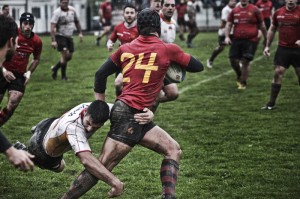By James Brown (@jamesbrown06)
The best houses are built on the best foundations
The contemporary field of injury prevention has broadened its focus from purely epidemiological to include social science evaluation tools over the past five years. For example, the RE-AIM framework has now become accepted as a injury prevention programme evaluation tool [1] [2]. The letters of the “RE-AIM” acronym indicate a different aspect of the programme to be assessed: Reach, Effectiveness, Adoption, Implementation and Maintenance. Finch and colleagues also described how the RE-AIM framework should be assessed within a Sports Setting Matrix [2], which looks at these aspects (Reach, Effectiveness, etc.) within different hierarchical levels. National Sports Organisations are at the top of this hierarchy due to their ability to change policy relating to sports safety, and as a result Finch and colleagues emphasise the importance of relationships between injury prevention practitioners and these NSOs.

Thus, the relationship between the South African Rugby Union (SARU) and two universities (University of Cape Town and Vrije University Medical Center) is an exemplary example of just such an NSO/injury prevention practitioner relationship. A critical ingredient to this gel was the active buy-in and confidence of the scientific process of the injury prevention practitioners (UCT/VUmc) from the SARU medical department. Without this, the work of the injury prevention practitioners may have been largely wasted.
Based on SARU’s support, they permitted UCT/VUmc access to analyse their rugby-related catastrophic injury data. Access to and publication of catastrophic injury data, in particular, can be a sticking point among NSO’s due to the assumed negative spin-off of giving the sport a negative image. Far from this attitude, SARU saw this relationship as an opportunity to improve the already extensive BokSmart nationwide injury prevention programme [3]. Based on the publications findings (full article HERE ), SARU changed scrum laws at the amateur level in order to make this phase of play safer in South Africa (more info HERE) almost immediately. The International Rugby Board (IRB) vindicated SARU in this controversial change, by declaring a similar scrum-law change internationally from 2014.
Dr Wayne Viljoen (SARU BokSmart manager) and Clint Readhead (SARU Medical manager) discussed this relationship recently at the 2013 American College of Sports Medicine conference in Indianapolis.
References
1. Collard D, Chinapaw M, Verhagen E, van Mechelen W. Process evaluation of a school based physical activity related injury prevention programme using the RE-AIM framework. BMC pediatrics. BioMed Central Ltd; 2010;10(1):86.
2. Finch CF, Donaldson A. A sports setting matrix for understanding the implementation context for community sport. British Journal of Sports Medicine. 2010 Oct 4;44(13):973–8.
3. Viljoen W, Patricios J. BokSmart – implementing a National Rugby Safety Programme. British Journal of Sports Medicine. 2012 Aug;46(10):692–3. (FREE FULL TEXT)
********************************
James Brown is a PhD student at the University of Capetown, South Africa. His PhD is evaluating the effectiveness of BokSmart – a nationwide injury-prevention programme for catastrophic injuries in rugby. Follow him @jamesbrown06 and http://wp.me/2UGKS